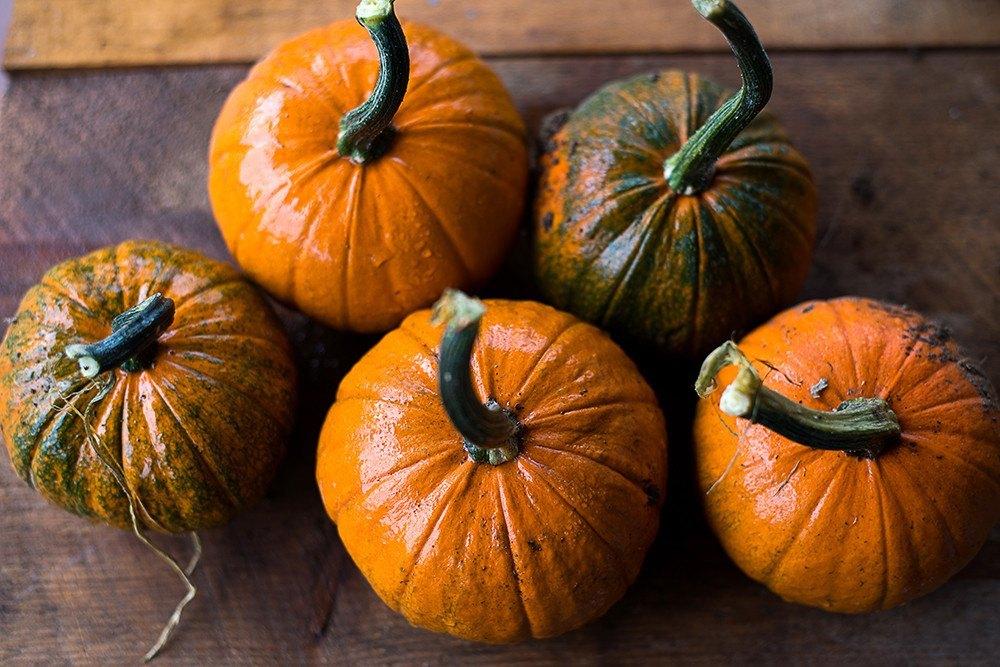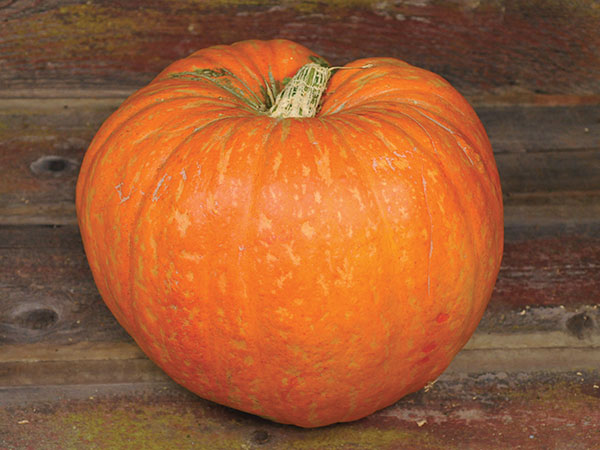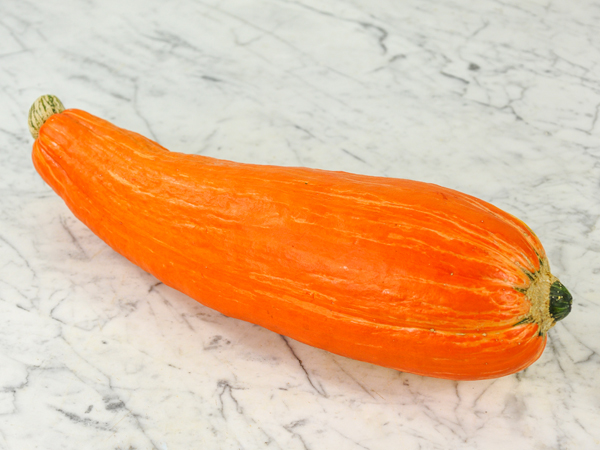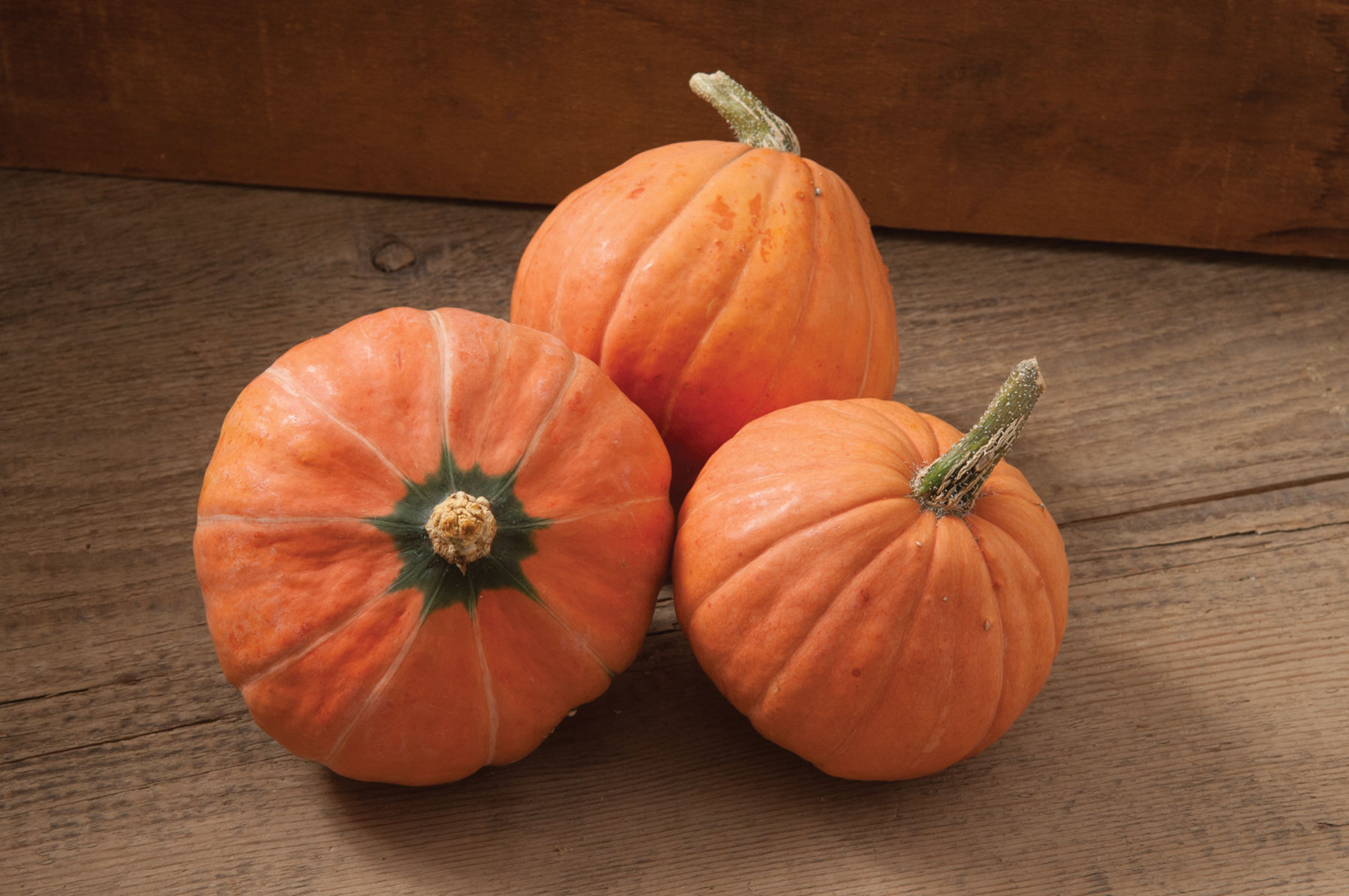|
|
This squash was obtained by James Robinson from Amish gardeners in the mountains of Maryland. The oval shaped and slightly pointed squash measures up to five inches thick and can weigh up to 60-80 pounds.
The Amish Pie Squash has pale orange flesh that is thick, sweet and moist. It is an excellent squash for making pies and for freezing. Seed Savers Exchange calls it "one of the best processing pumpkins we have ever grown". 120 days.
|

Suitable for eating. Ready to harvest when skin changes color.
Johnny’s Selected Seeds developed this novelty mini-pumpkin that received a 1993 All America Award. It’s small with a deep orange color and long, sturdy stem. Weighing less than 2 lbs. and averaging 5” in diameter, it’s appealing to kids of all ages who like to make jack-o-lanterns. The semi-hulless seeds are great for roasting and the flesh, when baked, is moist and flavorful. The vines are shorter than other varieties, but each plant produces 8-10 fruits.
Long handles and just the right size for little hands. This pumpkin is excellent to use for an individual "pumpkin bowl" to serve soups, stews and chili. The seeds are semi-hull-less and are excellent roasted.
Varieties:
Jack Be Little
Description: Mini pumpkin, pleasantly sweet with a chestnut flavor.
productive (8 to 20 fruits per foot), needs space.
Growth: 95 days.
Munchkin
Very small fruits (similar to the Jack be little variety), 5 to 8 cm in diameter and orange in color. Orange-yellow flesh, firm and sweet. Very good storage capacity of more than a year. Very good productivity. Each plant can produce from 6 to 15 fruits from 100 to 150 grams. The fruits are often used for decoration, in the company of colocynths. Variety ideal for carving, digging and putting small candles. Can also be stuffed. Growth: 95 days. This variety, originally from the USA, was developed by Harris Moran seed Seeds.
Zulu
Zulu is a pumpkin variety that originates from the eastern side of South Africa in the area around the Drakenburg Mountains. The fruit is round or slightly elongated with a slightly flattened top and bottom and smooth dark green rind that matures into a bright yellow colour. The medium length, thin vines produce fruit up to about 2.5kg in around 95 days. Inside, the flesh is a mid yellow colour, firm, dry, thick walled and mild to medium sweet. The rind is very thin but becomes very hard, which would make it a great long keeper.
Snack Jack
Little pumpkins, 1-2 1/2 lbs on compact bush plants. Orange fruit produce hulless seeds, that are great roasted as a snack. Mature in 100 days. There is a great variety in shapes, colors and types of squash, making them fun to grow. Seedlings should be gradually hardened off. Plants prefer rich, compost enriched soil. They will cross pollinate within their species. After harvest they should be ripened for 30 days in a cool location.
Important Info: The vines need plenty of room to sprawl, although some can be supported on a trellis. Summer squash or pumpkins should be sown indoors in flats in short season areas, 3-4 weeks before the night soil temperatures have warmed up.
Joko Japones
Joko Japones is an heirloom pumpkin variety from Bolivia. The fruit is small, round to slightly elongated, with a smooth rind that starts out green and matures into a strong orange colour. Growth wise, the small vines are prolific producers of fruit ranging from 0.5kg to 1.5kg in a very quick 85 days. Inside, the mellow yellow coloured flesh is firm, moist, medium sweet and tasty. The rind is very thin, but quickly becomes rock hard which would make them a great keeper.
Little Greenseed
Vining Pumpkin- Naked Seed. This Styrian-type pumpkin was bred for early yields of small, decorative halloween pumpkins and good quality dark green, naked seed. The fruit is solid orange with some variation in size and shape. The median is round with slight ribbing and usually 6-8" in diameter. The pumpkins ripen early but can remain in the field for an extended amount of time. Little Greenseed produces tasty, shell-less seeds which can be eaten right out of the ripe pumpkin or lightly skillet toasted for a minute or so for an exceptional treat. Little Greenseed is one of the earliest naked seed pumpkins and it also ranks high in seed productivity and number of fruits per plant. The vines are mostly restrained. The thicker fleshed pumpkins can be baked and used like an acorn squash since Baby Pam is in the pedigree. Little Greenseed produces pumpkins with variation and favorable characteristics that farmer breeders can use to make their own unique selections.
90 days.
|

Big Max pumpkins are extremely large, weighing anywhere between fifty and two hundred pounds. Their shape tends to be slightly slumped with a rounded top and flattened bottom. Its pink-orange skin is thick and deeply ribbed.
Stringy, watery flesh. Are often used for pies and canning. Also known as Big Mac.
Varieties:
Potiron d'Alencon
French variety, originally from Alençon, a city beneath le Mans.
Plant: trailing, needs 3 sqm; Fruits: cylindrical, red-orange; Size (DxH): 20 cm x 30 - 50 cm; Weight: 4 - 8 kg; Flesh: yellow-orange; thick, about 2-3 cm; crunchy, nutty flavour; Utilisation: for soup, pies, sweet dishes; Maturation: 90 days; Conservation: 3 - 5 months.
Seed Reviews:
Ornate Horticulture Society: this pumpkin has problems of pollination indeed sometimes the pumpkins are deformed and do not always have the desired shape and even the color.
P. Brown: I had the impression that it was not very well fertile, but very long foliage. I had fruit in the shape of a rugby ball as it should be, but also fruits round, here we have the same observation.
Golais
Very large, brilliant orange fruits are oblong, lightly ribbed. They do get large--60 pounds or larger is possible! Yet flavor and texture are not compromised. Makes great pumpkin pie. 120 days.
Mammoth Gold
|
|
Known as Navajo Calabasita, or Navajo Zucchini, can be used early as zucchini or as winter squash when mature. Turns from yellow young fruit to orange when mature. Cushaw type from Mexico. Weight: 2.5 kg.
|

This is the squash that gained fame online and became known as the “800 year old squash” which, according to legend, seed was found in a “clay ball” at an historic site in Wisconsin. But, other stories state that this squash was found in a cave by the Miami Nation. Whatever the story is, we know that squashes of this type have been grown by Native people in North America for hundreds of years and likely came from the Guatemala area, possibly over 1000 years ago. This fabulous Native American squash first came to our attention in 2015, at the 5th annual Heirloom Exposition in Santa Rosa, California. The magnificent fruits run about 2-3 feet long and weigh up to 18 pounds. The color is a rich, bright orange, with lighter orange striping running the length of the banana-shaped fruits. The surface is mildly bumpy; the overall appearance is amazingly beautiful. Gete-Okosimin also proves to be delicious--sweet, with hints of melon, and possessing a wonderful smooth texture. We thank Roger Smith for bringing this squash to our attention.
|
|
Also known as Pomme D'Or. This squash is the size and colour of an orange with smooth peel. Harvest when the stem is still green.
Very fine flavor, recalling that of the artichoke. Thin flesh. Hard bark of orange color when ripe. The fruits are kept for months and can even be dried. Growth: 80-130 days.
|

Suitable for cooking and pies.
Also known as Oriental pumpkin. Golden Nugget squashes at maturity boast a dull orange skin, vertically lined with fine ridges. About the size of a small grapefruit measuring just three to four inches in diameter and two pounds or less in weight the Golden Nugget squash has a round to oval shape similar to that of a pumpkin. Another pumpkin like characteristic of the Golden Nugget is its notable two to three-inch stem which is typically left attached after harvest as a means of extending the storage life of the squash. The interior flesh of Golden Nugget is bright orange and features a central seed cavity. When cooked the petite squash offers a starchy texture and sweet flavored flesh. The squash is considered best when cooked whole without removing seeds.
Bred originally by North Dakota State to be a sweet potato substitute for short seasoned growing regions. When released though it proved to be well adapted to many growing areas and caught on as a popular home garden squash as a result of its ability to stay compact and still provide a substantial yield of squash.
Golden Nugget squash was a 1966 All American Sections (AAS) winner, an award given to new crops which exhibit superiority in garden grown fruits and vegetable trials annually. It comes from the varieties "Banquet" and "Tapley's Bush". The variety "Banquet" is itself from a cross between "Buttercup" and "Gilmore".
Geography/History
Golden Nugget squash was developed in 1966 by Dr.Holland at the North Dakota Agricultural Experiment Station in Fargo, North Dakota. Growing in a bush fashion, the Golden Nugget is a compact plant which can provide higher yields per acre than other vine type squashes. Golden Nugget squash prefers well-drained soil and should not be planted until risk of frost has passed in the spring or early summer. Golden Nugget squash will be ready approximately eighty-five days from planting and should be harvested before the first frost of the fall.
Can be planted in your landscaping or in a very large pot. The bushy and compact plants extend over a meter. They produce from 3 to 5 fruits of orange color sometimes striped with green. Growth: 75-90 days.
F1 Hybrid: WIndsor
Unlike traditional pumpkins, Windsor won't go sprawling across your garden. Its compact habit makes it ideal for containers, and it will keep you supplied with tasty 15cm (6") diameter fruits throughout the season.
You don't have to have a large vegetable garden to grow your own. Even the smallest patio or balcony can accommodate a few containers that will give you a bumper crop of delicious fresh produce.
Amazonka
2-3 pound fruits ripen deep orange. Fruits are slightly flattened globes, are ribbed with some green striping along the ribs and the blossom end. Flesh is orange, and fine for all typical winter squash uses. Productive plants are compact, running 3-4 feet, making this an excellent choice for smaller gardens or container culture. Great keeper, too. A Russian commercial variety of recent introduction. 85 days.
|

Very suitable for cooking.Color-changing squash reveals ripeness
Cornell: The roots of Mazourek’s squash reach back to the 1980s at the New York State Agricultural Experiment Station in Geneva, where Richard W. Robinson, professor emeritus of horticulture, crossed a buttercup and a butternut squash.
“Michael Mazourek, a plant breeder at Cornell University, takes his cues from cooks to breed new ingredients that are flavorful, nutritious, resilient, and high-yielding. Together, we've collaborated on a number of experimental varieties, including the Honeynut squash, a butternut squash cross that fits in the palm of your hand and has about ten times the sweetness and squash flavor of the workaday butternut.”
—Dan Barber, Blue Hill, NYC
85 days. Climbing vine.
Reviews
Great, if you harvest early
Cute little one-serving size butternuts squashes. I need to harvest while they're still striped with green or the seed cavity has rotted. Leaving them till they're tan means the inside is spoiled. -grower
|
|
The absolute best pie pumpkin for cooking, with virtually stringless, smooth orange flesh.
Also known as Nantucket Pie. Harvest green with an orange spot on the bottom, as Long Pie ripens in storage, turning completely orange outside as flesh sweetens inside. Stores well. 5-8 lb fruit.
This very old variety is native to Maine in the USA. She was reportedly brought back from St Georges Island by a whaler to Nantucket, Maine in 1832. She was then known as "Nantucket Pumpkin". It is also called "Indian" or "Oblong". The Seedman Burpee offered it in 1888 under the name "Sr Georges". It seems very close to the variety "Golden Oblong" introduced by Burpee in 1889. In the late 1980s, LeRoy Souther, who had cultivated it for 30 years in Maine, entrusted seeds to John Navazio who reintroduced it with Seeds Garden City Seeds Montana.
|
|
|
|
|
Very tasty variety whose fruits can be consumed before full maturity. Epidermis and flesh of orange color. The fruits are from 2 kg to 2.5 kg. They are drum-shaped like those of the "Buttercup" variety. Very large storage capacity. Good productivity. Growth: 100 days.
It is very flavorful and never stringy.
Variety introduced by the University of Wisconsin in the USA. It was obtained during an improvement process initiated by Prof. James G. Moore, in 1958, from three varieties: "Golden Hubbard", "Rainbow" and "Greengold". With Mooregold, Prof. James G. Moore achieved his goal of creating a small squash with high quality dry flesh, without the "Buttercup" turban and the green colorings of "Greengold".
|
|
OP.
The noted small sugar pumpkin of New England. Also known as Sugar Pie Pumpkin, Pie pumpkin and Sugar pumpkin.
Dark orange-skinned pumpkins in a range of small sizes, typically 4-6 lb and six to eight inches in diameter. Although not as sweet as squash, the well-colored, orange flesh is relatively starchy, dry, and stringless. A well-known mini Jack O'Lantern type for pies. Avg. yield: 3-4 fruits/plant.
Geography/History
Sugar Pie pumpkins are a dwarf variety pumpkin bread specifically for use in cooking. This heirloom variety is believed to be native to the United States. Growing on vines Sugar Pie pumpkins are an annual vegetable and easy to grow provided they are grown after the last frost has occurred. Described by Fearing Burr in 1863.
Seed Reviews:
Grown successfully all over USA, Saskatchewan, Canada (zone 2), Ireland. Nice flavour, easy to grow.
Not successful in Florida; susceptible to bugs and pests.
|
|
This variety of pumpkin was a favourite of the Omaha Native Indian Tribe and was collected from them in the early 20th century. After trialing, it was released commercially in the USA in 1924. The fruit are only small but stand tall and cylindrical with orange coloured rind with slight creases.The flesh is a creamy yellow shade, sweet, tasty and a fair amount of it for a small pumpkin.The vines are vigorous, but thin and very productive. First fruit picked at 95 days. Fruit weighs from 1kg to 2.5kg and has a milder flavour.
Varieties:
Candelaria
origin: Southeastern United States, Mexico. Chilean variety.
runner: yes
fruit: Long cylindrical orange.
fruit size: 30 cm in diameter. Length 40 cm.
weight: 5 to 14 kg.
epidermis: Smooth and fine.
flesh: Orange, thick and soft.
It offers 2 or 3 fruits per feet of good quality.
growth: 100 to 140 days.
|
|
This attractive pumpkin is moderately sized and is a beautiful soft cream with orange stripes and speckles. It can be inconsistent in production, and we never know from year to year if they will be big and flat or barrel shaped.
The One Too Many pumpkin is said to be so named because the underside looks like a bloodshot eye.
|

Known as Gialla Quintale or Yellow Quintale.
Italian variety similar to the Gialla Grossa of Paris . It is our variety of giant pumpkin,
which can reach considerable size. The flesh is yellow, compact and slightly sugary.
Typical large variety with slightly thick, large round fruits with a yellowish skin. Very appreciated in the Mediterranean diet for the preparation of soups or baked in the oven and seasoned with oil and vinegar for side dishes of special dishes. Sowing: April-May in full campp. Distance: about 1.5 meters from row to row. 100 cm on the row. Slightly varied, slightly peeled, peel of yellow color. Flesh of yellow or orange color.
Varieties:
Rochetta
Giant pumpkin from Italy, similar to the Quintale pumpkin, but with a white streak absent in the latter. Originally from the upper Val Bormida, in the province of Savona, it was cultivated at the family level, in an area where agriculture is poorly developed. Used for soups and velvety creams, or fried or even for jam. Progressively abandoned, its cultivation has been relaunched by Slow Food Val Bormida, spreading it among the members, on the basis of seeds traced to an elderly farmer.
|
|
Beautiful glowing gold acorn-shaped fruit are perfect for fall displays. Nutty flavored yellow flesh; compact bush plants produce 1 1/2 lb. fruit. Pick this one young and sell as a specialty summer squash, as they are tender and delicious. 85 days
It is also called "Golden Acorn Jersey". Contains more vitamin A than other acorns.
flesh: Orange and thick.
description / information: Variety of easy culture of very good quality.
It offers 5 to 8 sweet flavors per foot.
This variety was developed by O. Shifriss at Rutgers University in New Jersey.
He had named it Jersey Golden Acorn.
growth: 90 to 120 days.
Varieties:
Gills' Golden Pippin Squash
An heirloom from the Gill Brothers Seed Company of Oregon. 85 days.
Red Royal
Pumpkin of American origin, belonging to the group "Acorn", which has a characteristic shape of an acorn.
Unlike the Table Queen, it has been orange-orange since the very beginning.
Taste improves with conservation.
|

An heirloom variety with fantastic cooking quality. This small pumpkin has a unique, netted skin. Winter Luxury is not only a gorgeous ornamental, but is also superb for eating.
Winter Luxury is an heirloom pie pumpkin that made its debut in 1893 by Johnson & Stokes Seed Co. It has sweet, smooth flesh, that is great for pie, cheesecake or soup. This year, they are ranging in size from 5 to 12+ pounds.
Winter Luxury Pie Squash was developed by a farmer. Johnson & Stokes of Philadelphia acquired the rights to it, and released it in 1893. According to Amy Goldman, this version was developed by an anonymous farmer. At the time, it had pale yellow flesh very close to the famous variety "Sugar Pumpkin". Ray W. and Edward E. Gill, of the Gill Brothers Seed Company, Portland, Oregon, released an improved variety in 1917 with increased size.
The French variety "Melonnette Jaspée de Vendée" seems very close to the "Winter Luxury" variety of origin. "Winter Luxury" is also known by many other names: "Golden Russet", "Livingston's Pie Squash", "Luxury Pie", "Queen Luxury", "Winter Queen", etc.
Varieties:
Jaspee De Vendee
Runner variety bearing many fruits in the appearance of melon embroidered yellow-orange, because the epidermis is covered with many corky cracks. The flesh is very sweet, orange in color. Each plant produces 5 to 7 fruits of 1 to 3 kg. keeps for a few months.
Very old variety from France that is also called "Melonnette Saint Julien de Concelles".
Plant extends about 3 meters.
Can harvest young for fast consumption, or at maturity, just before the frosts. Tastes really good after 4 months in storage.
growth: 95 to 120 days
|
|
|
 MBZ
MBZ
